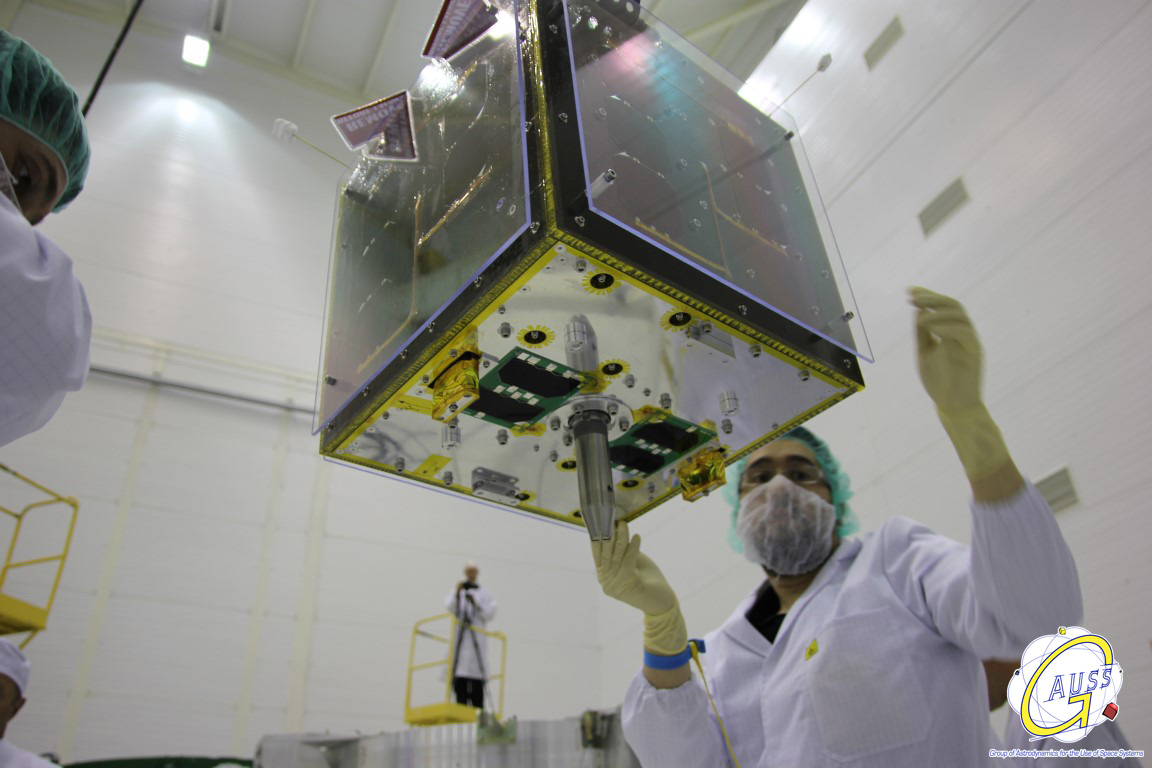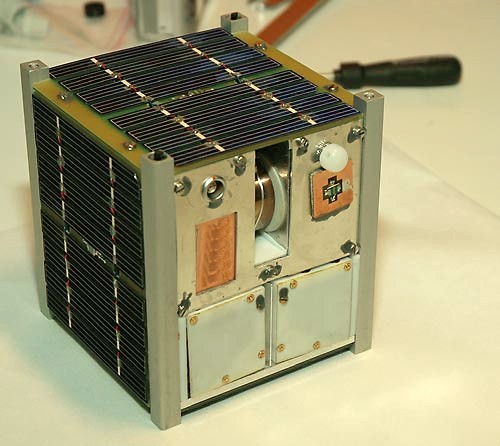|
OPUSAT
The Osaka Prefecture University Satellite, or OPUSAT was a technology demonstration cubesat built and operated by Japan's Osaka Prefecture University. It had a size of 100x100x100mm (without antennas and solar paddles) and build around a standard 1U cubesat bus. The primary satellite purpose was the space testing of the power system based on a Lithium-ion capacitor. The tests were largely successful, and it finished operation by reentry to Earth atmosphere on 24 July 2014. The OPUSAT was a development successor to “Maido Ichigo” satellite by East Osaka Craftmen Astro-Technology SOHLA in Osaka. See also * List of CubeSats *OPUSAT-II OPUSAT-II (COSPAR 1998-067SG, SATCAT 47930) was a CubeSat developed by Osaka Prefecture University and Muroran Institute of Technology. OPUSAT-II was launched from Wallops Flight Facility on 20 February 2021, and was deployed from the Internatio ... References External links Official HomepageOPUSAT Packet Decoder Description and block diag ... [...More Info...] [...Related Items...] OR: [Wikipedia] [Google] [Baidu] |
OPUSAT-II
OPUSAT-II (COSPAR 1998-067SG, SATCAT 47930) was a CubeSat developed by Osaka Prefecture University and Muroran Institute of Technology. OPUSAT-II was launched from Wallops Flight Facility on 20 February 2021, and was deployed from the International Space Station. The satellite was nicknamed HIROGARI, for a Japanese word meaning spread, or expand. Spacecraft The satellite's satellite bus was based on the design of Osaka Prefecture University's previous satellite, OPUSAT, which was launched in 2014. OPUSAT-II had a design life of five and a half months. Mission OPUSAT-II had two main missions. The first mission was to demonstrate high-speed data transmission in amateur radio band. According to the project's website, the satellite communication system's design and the results of the experiment would be made public. The second mission was a deployment of a large folded structure. A deployable plastic plate was stored inside the satellite, based on Miura fold. The folding method t ... [...More Info...] [...Related Items...] OR: [Wikipedia] [Google] [Baidu] |
H-IIA
H-IIA (H-2A) is an active expendable launch system operated by Mitsubishi Heavy Industries (MHI) for the Japan Aerospace Exploration Agency. These liquid fuel rockets have been used to launch satellites into geostationary orbit; lunar orbiting spacecraft; '' Akatsuki'', which studied the planet Venus; and the Emirates Mars Mission, which was launched to Mars in July 2020. Launches occur at the Tanegashima Space Center. The H-IIA first flew in 2001. , H-IIA rockets were launched 45 times, including 39 consecutive missions without a failure, dating back to 29 November 2003. Production and management of the H-IIA shifted from JAXA to MHI on 1 April 2007. Flight 13, which launched the lunar orbiter SELENE, was the first H-IIA launched after this privatization. The H-IIA is a derivative of the earlier H-II rocket, substantially redesigned to improve reliability and minimize costs. There have been four variants, with two in active service (as of 2020) for various purposes. A ... [...More Info...] [...Related Items...] OR: [Wikipedia] [Google] [Baidu] |
List Of CubeSats
The following is a list of CubeSats, nanosatellites used primarily by universities for research missions, typically in low Earth orbits. Some CubeSats became their country's first national satellite. The extensivNanosatellite and CubeSat Databaselists nearly 4,000 CubeSats and NanoSats have been launched since 1998. The organization forecasts that 2080 nanosats will launch within the next 6 years. Research and development * SBUDNIC was launched to test Arduino Nano and other commercial off-the-shelf technology in space, using a simple, open-source design. * An ambitious project is the QB50, an international network of 50 CubeSats for multi-point by different universities and other teams, ''in-situ'' measurements in the lower thermosphere (90–350 km) and re-entry research. QB50 is an initiative of the von Karman Institute and is funded by the European Union. Double-unit ("2-U") CubeSats (10x10x20 cm) are foreseen, with one unit (the 'functional' unit) providing the usual sat ... [...More Info...] [...Related Items...] OR: [Wikipedia] [Google] [Baidu] |
Osaka Prefecture University
(OPU), also abbreviated to , is one of the largest public universities in Japan. The main campus is among big Kofun tombs in Sakai, Osaka. The university will merge with Osaka City University to form Osaka Metropolitan University (OMU) in April 2022. History . OPU was established in 2005 in its current form by integrating three prefectural universities: University of Osaka Prefecture (), Osaka Women's University () and Osaka Prefecture College of Nursing (). In June 2020, OPU announced that it would be merging with Osaka City University to become the ''University of Osaka''. However, after the name was announced on June 26, 2020, Osaka University President released a statement pointing out that the English version of the new university's name was "remarkably similar" to that of Osaka University, adding, "It will cause confusion among our students, and work as a great obstacle for the future of both universities, which are reaching out to the world." University of Osak ... [...More Info...] [...Related Items...] OR: [Wikipedia] [Google] [Baidu] |
CubeSat
A CubeSat is a class of miniaturized satellite based around a form factor consisting of cubes. CubeSats have a mass of no more than per unit, and often use commercial off-the-shelf (COTS) components for their electronics and structure. CubeSats are put into orbit by deployers on the International Space Station, or launched as secondary payloads on a launch vehicle. , more than 1,600 CubeSats have been launched. In 1999, California Polytechnic State University (Cal Poly) professor Jordi Puig-Suari and Bob Twiggs, a professor at Stanford University Space Systems Development Laboratory, developed the CubeSat specifications to promote and develop the skills necessary for the design, manufacture, and testing of small satellites intended for low Earth orbit (LEO) that perform a number of scientific research functions and explore new space technologies. Academia accounted for the majority of CubeSat launches until 2013, when more than half of launches were for non-academic purposes, ... [...More Info...] [...Related Items...] OR: [Wikipedia] [Google] [Baidu] |
Tanegashima Space Center
The (TNSC) is the largest rocket-launch complex in Japan with a total area of about 9.7 square kilometers. It is located on the southeast coast of Tanegashima, an island approximately south of Kyushu. It was established in 1969 when the National Space Development Agency of Japan (NASDA) was formed, and is now run by JAXA. The activities that take place at TNSC include assembly, testing, launching, and tracking satellites, as well as rocket engine firing tests. Facilities On-site main facilities include: * Yoshinobu Launch Complex is a launch site for launch vehicles like the H-IIA * Vehicle Assembly Building (VAB) * Second Spacecraft Test and Assembly Building * Takesaki Range Control Center Those facilities are used for performing operations from assembling launch vehicles, maintenance, inspections, final checks of satellites, loading satellites onto launch vehicles, rocket launches, and tracking launch vehicles after liftoff. The TNSC plays a pivotal role in satellit ... [...More Info...] [...Related Items...] OR: [Wikipedia] [Google] [Baidu] |
Yoshinobu Launch Complex
Yoshinobu Launch Complex (LC-Y) is a rocket launch site at the Tanegashima Space Center on Tanegashima. The site and its collection of facilities were originally built for the H-II launch vehicle and later used for H-IIA and H-IIB launches. It is the most Northern launch complex at Tanegashima, and along with the now inactive Osaki Launch Complex used for orbital launches. The Yoshinobu Launch Complex consists of two launch pads. The complex also contains a test stand for firing the LE-7 engines used in the first stage of the H-II and its derivatives. Prior to launch, rockets are processed vertically in the complex's vehicle assembly building. The rocket is rolled out to the launch pad on a mobile launcher platform A mobile launcher platform (MLP), also known as mobile launch platform, is a structure used to support a large multistage space vehicle which is assembled (stacked) vertically in an integration facility (e.g. the Vehicle Assembly Building) and t ... about twelv ... [...More Info...] [...Related Items...] OR: [Wikipedia] [Google] [Baidu] |
Mitsubishi Heavy Industries
is a Japanese multinational engineering, electrical equipment and electronics corporation headquartered in Tokyo, Japan. MHI is one of the core companies of the Mitsubishi Group and its automobile division is the predecessor of Mitsubishi Motors. MHI's products include aerospace and automotive components, air conditioners, elevators, forklift trucks, hydraulic equipment, printing machines, missiles, tanks, power systems, ships, aircraft, railway systems, and space launch vehicles. Through its defense-related activities, it is the world's 23rd-largest defense contractor measured by 2011 defense revenues and the largest based in Japan. History In 1857, at the request of the Tokugawa Shogunate, a group of Dutch engineers were invited, including Dutch naval engineer Hendrik Hardes, and began work on the ''Nagasaki Yotetsusho'' 長崎鎔鉄所 , a modern, Western-style foundry and shipyard near the Dutch settlement of Dejima, at Nagasaki. This was renamed ''Naga ... [...More Info...] [...Related Items...] OR: [Wikipedia] [Google] [Baidu] |
Geocentric Orbit
A geocentric orbit or Earth orbit involves any object orbiting Earth, such as the Moon or artificial satellites. In 1997, NASA estimated there were approximately 2,465 artificial satellite payloads orbiting Earth and 6,216 pieces of space debris as tracked by the Goddard Space Flight Center. More than 16,291 objects previously launched have undergone orbital decay and entered Earth's atmosphere. A spacecraft enters orbit when its centripetal acceleration due to gravity is less than or equal to the centrifugal acceleration due to the horizontal component of its velocity. For a low Earth orbit, this velocity is about ; by contrast, the fastest crewed airplane speed ever achieved (excluding speeds achieved by deorbiting spacecraft) was in 1967 by the North American X-15. The energy required to reach Earth orbital velocity at an altitude of is about 36 MJ/kg, which is six times the energy needed merely to climb to the corresponding altitude. Spacecraft with a perigee belo ... [...More Info...] [...Related Items...] OR: [Wikipedia] [Google] [Baidu] |
Low Earth Orbit
A low Earth orbit (LEO) is an orbit around Earth with a period of 128 minutes or less (making at least 11.25 orbits per day) and an eccentricity less than 0.25. Most of the artificial objects in outer space are in LEO, with an altitude never more than about one-third of the radius of Earth. The term ''LEO region'' is also used for the area of space below an altitude of (about one-third of Earth's radius). Objects in orbits that pass through this zone, even if they have an apogee further out or are sub-orbital, are carefully tracked since they present a collision risk to the many LEO satellites. All crewed space stations to date have been within LEO. From 1968 to 1972, the Apollo program's lunar missions sent humans beyond LEO. Since the end of the Apollo program, no human spaceflights have been beyond LEO. Defining characteristics A wide variety of sources define LEO in terms of altitude. The altitude of an object in an elliptic orbit can vary significantly along the orbit. ... [...More Info...] [...Related Items...] OR: [Wikipedia] [Google] [Baidu] |
Cubesat
A CubeSat is a class of miniaturized satellite based around a form factor consisting of cubes. CubeSats have a mass of no more than per unit, and often use commercial off-the-shelf (COTS) components for their electronics and structure. CubeSats are put into orbit by deployers on the International Space Station, or launched as secondary payloads on a launch vehicle. , more than 1,600 CubeSats have been launched. In 1999, California Polytechnic State University (Cal Poly) professor Jordi Puig-Suari and Bob Twiggs, a professor at Stanford University Space Systems Development Laboratory, developed the CubeSat specifications to promote and develop the skills necessary for the design, manufacture, and testing of small satellites intended for low Earth orbit (LEO) that perform a number of scientific research functions and explore new space technologies. Academia accounted for the majority of CubeSat launches until 2013, when more than half of launches were for non-academic purposes, ... [...More Info...] [...Related Items...] OR: [Wikipedia] [Google] [Baidu] |
Japan
Japan ( ja, 日本, or , and formally , ''Nihonkoku'') is an island country in East Asia. It is situated in the northwest Pacific Ocean, and is bordered on the west by the Sea of Japan, while extending from the Sea of Okhotsk in the north toward the East China Sea, Philippine Sea, and Taiwan in the south. Japan is a part of the Ring of Fire, and spans Japanese archipelago, an archipelago of List of islands of Japan, 6852 islands covering ; the five main islands are Hokkaido, Honshu (the "mainland"), Shikoku, Kyushu, and Okinawa Island, Okinawa. Tokyo is the Capital of Japan, nation's capital and largest city, followed by Yokohama, Osaka, Nagoya, Sapporo, Fukuoka, Kobe, and Kyoto. Japan is the List of countries and dependencies by population, eleventh most populous country in the world, as well as one of the List of countries and dependencies by population density, most densely populated and Urbanization by country, urbanized. About three-fourths of Geography of Japan, the c ... [...More Info...] [...Related Items...] OR: [Wikipedia] [Google] [Baidu] |



_pre-launch.jpg)
